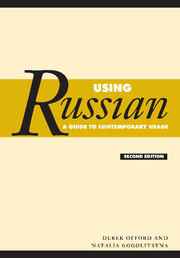Book contents
- Frontmatter
- Contents
- Preface to the first edition
- Preface to the second edition
- Acknowledgements
- Sources
- Note on transcription, stress marks and transliteration
- Glossary of linguistic terms
- List of abbreviations
- 1 Varieties of language and register
- 2 Passages illustrating register
- 3 Problems of meaning: Russian words
- 4 Problems of translation from English into Russian
- 5 Vocabulary and idiom
- 6 Language and everyday life
- 7 Verbal etiquette
- 8 Word-formation
- 9 Inflection
- 10 Prepositions
- 11 Syntax
- 12 Stress
- Index of Russian words, phrases and affixes
- General index
Preface to the second edition
Published online by Cambridge University Press: 05 June 2012
- Frontmatter
- Contents
- Preface to the first edition
- Preface to the second edition
- Acknowledgements
- Sources
- Note on transcription, stress marks and transliteration
- Glossary of linguistic terms
- List of abbreviations
- 1 Varieties of language and register
- 2 Passages illustrating register
- 3 Problems of meaning: Russian words
- 4 Problems of translation from English into Russian
- 5 Vocabulary and idiom
- 6 Language and everyday life
- 7 Verbal etiquette
- 8 Word-formation
- 9 Inflection
- 10 Prepositions
- 11 Syntax
- 12 Stress
- Index of Russian words, phrases and affixes
- General index
Summary
This new edition of Using Russian: a Guide to Contemporary Usage represents an extensively revised and augmented version of the first edition, which was published in 1996. Whereas the first edition consisted of ten chapters the current edition has twelve and is some ninety pages longer than the first. Our thanks are due to Cambridge University Press for allowing this enlargement.
Some material in the first edition that is now out-of-date or that is for some other reason of less interest than it was in 1996 (for example, neologisms associated with the period of glásnost′ and perestróika) has been excised or reduced. On the other hand, much fresh material has been incorporated, especially in the first five chapters and the last chapter. The main changes that have been made are as follows.
Chapter 1 is based on sections 1–5 inclusive of the first chapter of the first edition but the material has been substantially rewritten and considerably expanded. Section 1.1, on the distribution of the Russian language, has been revised in the light of information in the most recent Russian census (2002). Section 1.2, on varieties of language, has been slightly expanded to include material on the distinction drawn, for example by David Crystal, between written and spoken language. Section 1.3, on registers in contemporary Russian, contains some fresh examples of usage and a new section (1.3.6) on the language of the internet (a subject to which this new edition as a whole pays much attention).
- Type
- Chapter
- Information
- Using RussianA Guide to Contemporary Usage, pp. xv - xviiPublisher: Cambridge University PressPrint publication year: 2005



